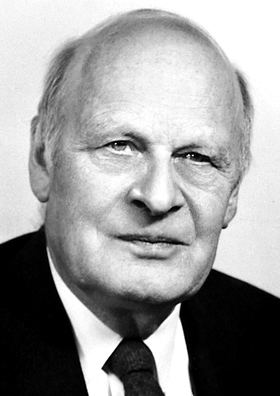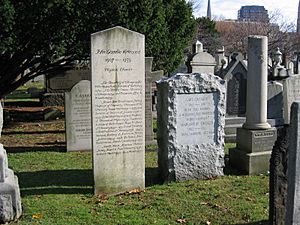Lars Onsager facts for kids
Quick facts for kids
Lars Onsager
|
|
|---|---|

Lars Onsager, 1968
|
|
| Born | November 27, 1903 |
| Died | October 5, 1976 (aged 72) Coral Gables, Florida, U.S.
|
| Nationality | Norway, U.S. |
| Occupation | Theorectical Chemistry |
| Known for | Noble Prize in Chemistry, 1968 |
Lars Onsager (born November 27, 1903 – died October 5, 1976) was a brilliant scientist. He was born in Norway but later became an American citizen. He was a physical chemist and a theoretical physicist. This means he studied how chemicals work using physics and math. He taught at Yale University and won the Nobel Prize in Chemistry in 1968.
Contents
Early Life and School
Lars Onsager was born in Kristiania, Norway. This city is now known as Oslo. His father worked as a lawyer. After finishing high school in Oslo, Lars went to the Norwegian Institute of Technology. This school was in Trondheim. He studied chemical engineering and graduated in 1925.
His Scientific Work
In 1925, Lars Onsager found a mistake in a well-known science theory. This theory was about how tiny particles move in liquids. It was called the Debye-Hückel theory. In 1926, he published his corrections to the theory.
He then traveled to Zürich to meet Peter Debye. Debye was the scientist who created the theory. Lars told him his theory was wrong. Debye was very impressed by Lars's work. He asked Lars to become his assistant. Lars Onsager stayed at the Eidgenössische Technische Hochschule (ETH) until 1928.
Teaching in the United States
In 1928, Lars Onsager moved to the United States. He started teaching at Johns Hopkins University in Baltimore, Maryland. Lars was great at creating new scientific ideas. However, he was not very good at teaching chemistry to students. Because of this, he was let go after only one semester.
His next job was teaching at Brown University in Providence, Rhode Island. Here, he taught about statistical mechanics. Again, he was not a good teacher. But he still made important discoveries in this field. He also worked on thermodynamics. One student, Raymond Fuoss, understood his lectures well. Fuoss later joined him at Yale University. In 1933, during the Great Depression, Brown University let him go. They felt they could not afford someone who struggled with teaching.
While at Brown, Lars Onsager studied how temperature changes affect how things spread out. In 1929, he developed a set of equations. These are now known as the Onsager reciprocal relations. For many years, people did not realize how important these equations were. But by 1968, they were seen as a major reason for him to win the Nobel Prize.
In 1933, after leaving Brown, Lars traveled to Austria. He visited a scientist named Hans Falkenhagen. There, he met Margrethe Arledter, Hans's sister-in-law. They got married on September 7, 1933. They had three sons and one daughter.
Years at Yale University
Lars Onsager's next job was at Yale University. He stayed there for most of his life. He retired from Yale in 1972. At Yale, people found out he had never earned a Ph.D. The Norwegian Institute of Technology said his work on reciprocal relations was not complete enough for a doctorate. Yale offered to accept one of his published papers instead. But Lars wanted to do a new research project.
His new research paper was very complex. It was called "Solutions of the Mathieu equation of period 4 pi and certain related functions." It was so hard that the chemistry and physics teachers at Yale could not understand it. Only after the mathematics department offered to give him the doctorate did he get his Ph.D. in chemistry in 1935. He became an assistant professor in 1934 and an associate professor in 1940.
At Yale, he continued to do amazing theoretical research. But he still found it hard to teach or explain his ideas to students. He also struggled to guide graduate students, except for a few very talented ones.
In the late 1930s, Lars Onsager studied the dipole theory of dielectrics. He improved on earlier work by Peter Debye again. However, when he sent his paper to a journal that Debye edited in 1936, it was rejected. Debye did not accept Lars's ideas until after World War II.
During the 1940s, Lars Onsager studied how materials change from one state to another. He created a mathematical theory that was very well received. In 1944, he solved a very difficult math problem. This was about the two-dimensional Ising model.
In 1945, Lars Onsager became an American citizen. He was given the title of J. Willard Gibbs Professor of Theoretical Chemistry. Willard Gibbs was a famous scientist who used math to solve problems in physics and chemistry. Lars Onsager continued to work in the same areas that Gibbs had started.
In 1947, Lars Onsager was chosen to join the National Academy of Sciences. In 1950, he joined Alpha Chi Sigma, a professional chemistry fraternity.
After World War II, Lars Onsager explored new scientific topics. In 1949, he created a theory to explain why liquid helium acts like a superfluid. This means it can flow without any friction. Two years later, the physicist Richard Feynman came up with the same theory on his own. Lars also worked on theories about liquid crystals. He studied the electrical properties of ice. While on a special scholarship at the University of Cambridge, he researched the magnetic properties of metals. He developed important ideas about how magnetism works in metals.
He received many awards for his work. He won the Lorentz Medal in 1958. He also won the Willard Gibbs Award in 1962. In 1968, he was awarded the Nobel Prize in Chemistry. In 1975, he was elected a Foreign Member of the Royal Society.
After Yale University
In 1972, Lars Onsager retired from Yale. He became a member of the Center for Theoretical Studies at the University of Miami. He was also named a Distinguished University Professor of Physics. At the University of Miami, his teaching skills had improved. He guided and inspired students who were working on their postdoctoral research.
He became interested in new areas of science. These included semiconductor physics, biophysics, and radiation chemistry. However, he passed away before he could make any new major discoveries like those from his earlier years.
Personal Life
Lars Onsager died in 1976 from an aneurysm. He was living in Coral Gables, Florida, at the time. He was buried next to John Gamble Kirkwood. Their graves are in New Haven's Grove Street Cemetery. Lars Onsager's tombstone simply said "Nobel Laureate." When his wife, Gretel, died in 1991, she was buried there too. His children then added an asterisk after "Nobel Laureate" and "*etc." in the corner of the stone.
Legacy
The Norwegian Institute of Technology created the Lars Onsager Lecture in 1993. They also started the Lars Onsager Professorship. These awards honor great scientists in Chemistry, Physics, and Mathematics. In 1997, his children gave his scientific papers and belongings to NTNU. This university was formerly the Norwegian Institute of Technology. These items are now kept in The Lars Onsager Archive at the Gunnerus Library in Trondheim.
The Lars Onsager Prize is an award given in theoretical statistical physics. The American Physical Society gives it out every year. It was created in 1993 by Drs. Russell and Marian Donnelly.
Images for kids
See also
 In Spanish: Lars Onsager para niños
In Spanish: Lars Onsager para niños



